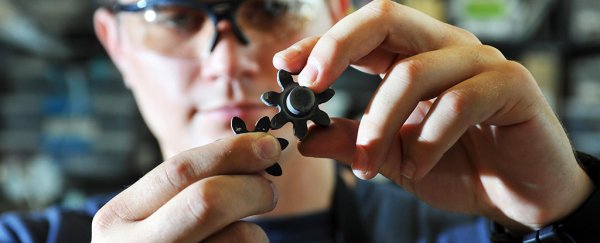Scientists have successfully pumped molten metal in a custom-made machine at a temperature of 1,400°C (2,552°F), a leap forward that could be used to upgrade the capabilities of solar thermal plants across the world.
Usually, shifting liquid metal at anything much above 1,000°C (1,832°F) causes the material it's held in to break under the heat, thus limiting the amount of energy we can store as heat in facilities like the Crescent Dunes plant near Las Vegas.
To get around this limitation, the team from the Georgia Institute of Technology, Stanford, and Purdue University in Indiana, engineered a special kind of ceramic that could accommodate the expansion and contraction that comes along with the intense heat. The pump was then sealed with graphite and filled with nitrogen.
Along with the materials advances, the pump is also designed so that the gear teeth and motor are deliberately misaligned – the expansion that follows its exposure to extreme heat then aligns them properly to do the job at the heat levels we've never achieved before.
 The pump in action. Credit: Caleb Amy
The pump in action. Credit: Caleb Amy
"The hotter you can operate, the more you can convert thermal energy to mechanical energy or electrical energy," says one of the researchers, Asegun Henry from Georgia Tech.
"But when containment materials like metals get hot, they become soft and that limits the whole infrastructure."
The new pump enables better ways to store the energy we capture from the Sun, using materials like molten tin and molten silicon that were previously off limits because we simply couldn't build a pump strong enough to hold them.
Store energy in this way and we can get more energy out while putting less in, thanks to efficiency improvements over existing materials like molten salt, which is typically stored at just 566°C (1,051°F).
The whole operation would be cheaper too: solar thermal plants could increase efficiency by around 50 percent using the new pump and hotter materials, estimate the scientists, reducing costs by 20 to 30 percent along the way.
"The hotter we can operate, the more efficiently we can store and utilise thermal energy," explains Henry. "This work will provide a step change in the infrastructure because now we can use some of the highest temperature materials to transfer heat."
Further down the line the researchers think the high temperature pump could be used to get hydrogen out of methane without generating carbon dioxide at the same time – another potential route to using hydrogen as a clean energy source.
Although the Shapal ceramic used in the team's experiments showed signs of wear, the researchers think a harder ceramic would solve that problem quite easily, and efforts are already underway on an improved version.
What's more, the team thinks temperatures past 2,000°C (3,632°F) could be possible, and that scaling the pump up for industrial use wouldn't present too much of a problem.
"Until now, we've had a ceiling for the highest temperatures at which we could move heat and store it, so this demonstration really enables energy advances, especially in renewables," says Henry.
The research has been published in Nature.
The researchers also put together a video of the experiment, which you can see below:
